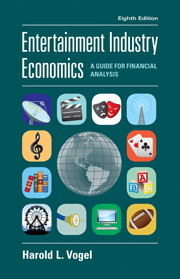Book contents
- Frontmatter
- Contents
- Preface
- Entertainment Industry Economics
- PART I Introduction
- PART II Media-dependent entertainment
- Chapter 3 Movie macroeconomics
- Chapter 4 Making and marketing movies
- Chapter 5 Financial accounting in movies and television
- Chapter 6 Music
- Chapter 7 Broadcasting
- Chapter 8 Cable
- Chapter 9 Publishing
- Chapter 10 Toys and games
- PART III Live entertainment
- PART IV Roundup
- Appendix A Sources of information
- Appendix B Major games of chance
- Appendix C Supplementary data
- Glossary
- References
- Index
- References
Chapter 6 - Music
from PART II - Media-dependent entertainment
Published online by Cambridge University Press: 01 June 2011
- Frontmatter
- Contents
- Preface
- Entertainment Industry Economics
- PART I Introduction
- PART II Media-dependent entertainment
- Chapter 3 Movie macroeconomics
- Chapter 4 Making and marketing movies
- Chapter 5 Financial accounting in movies and television
- Chapter 6 Music
- Chapter 7 Broadcasting
- Chapter 8 Cable
- Chapter 9 Publishing
- Chapter 10 Toys and games
- PART III Live entertainment
- PART IV Roundup
- Appendix A Sources of information
- Appendix B Major games of chance
- Appendix C Supplementary data
- Glossary
- References
- Index
- References
Summary
Life in the fast lane's no fun if you're running out of gas.
– HVThat is exactly what people in the music business discovered toward the end of the 1970s, when after three uninterrupted decades of expansion, recorded-music sales stopped growing. A new spurt of growth started in the mid-1980s and then carried through to the late 1990s, when the industry peaked with aggregate worldwide revenues of some $40 billion per year. Since then, problems have abounded.
Still, however, music is the most easily personalized and accessible form of entertainment, and it readily pervades virtually every culture and every level of society. Indeed, prior to the advent of recording technology, music was an integral and inseparable part of the social fabric. As such, music may be considered the most fundamental of all the entertainment businesses.
Feeling groovy
Experimentation with reproduction of moving images can be traced back to the early 1800s. But there was apparently limited interest in the mechanical reproduction of sound until the venerable Thomas Edison in 1877 developed yet another of his novelty items – a tinfoil-wrapped cylinder that was rotated with a handle. While he cranked the handle and recited the nursery rhyme “Mary Had a Little Lamb” into a recording horn, Edison's voice vibrated a diaphragm to which a metal stylus was attached.
- Type
- Chapter
- Information
- Entertainment Industry EconomicsA Guide for Financial Analysis, pp. 244 - 286Publisher: Cambridge University PressPrint publication year: 2010



